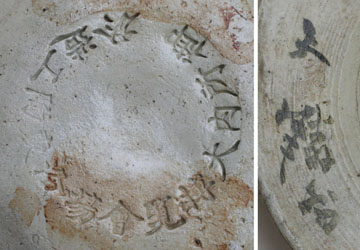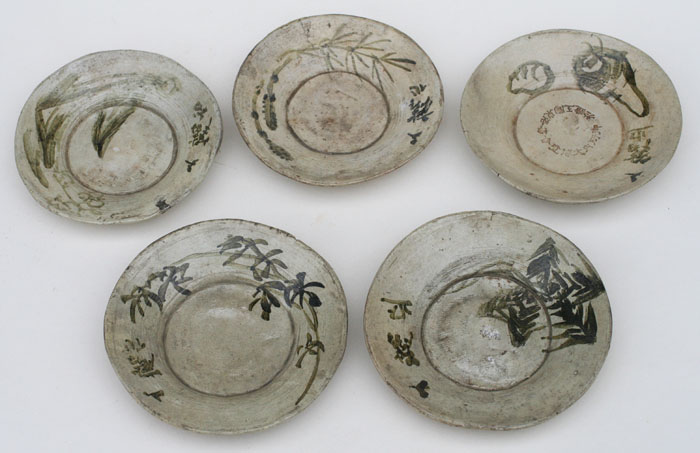Shijô
Set of 5 plates, zara, vegatablesSigned: Bunrin sha, Bunrin saku & Bunrin sei
Seals:
Technique: Brittle grey earthenware from Kyoto with brown underglaze paintings Ø 14,5 cm
Date: 1871
Condition: One dish has a stress crack, and another a tiny restauration, otherwise very good
A rare set of five dishes hand painted by Shiokawa Bunrin in commemoration of the Gosho-Nai Dai-Hakurankai (Exposition of pottery in the Imperial Palace, Kyoto) seal impression at the botom with the name of the event
御所内大博覧會植洛東陶工造於
Gosho-Nai Dai-Hakurankai shoku rakutô (Eastern Kyoto) tôkôzô oite
1. Tsukushi, horse tail, sugina
2. Imo, patatoe
3. Tanpopo, dandelion
4. Kuwai, arrowhead
5.
If any one artist created Nihonga it would have to be Bunrin. He walked the boundaries of the Maruyama-Shijô style and searched for new interpretations in the Nanga style. On top of that he experimented with new painting methods. Through Kôno Bairei (1844-1895), his major pupil, his influence reached well into the twentieth century.
Bunrin’s father was in the service of the Takatsukase family. When in 1820 both his parents died he was sent to Kyoto to study painting. Soon thereafter the head of the Takatsukase family recognized his talent and arranged a place in Toyohiko’s studio (together with a lifetime allowance of rice). He received his training in the Maruyama –Shijô style, but at least as important was his access to Toyohiko’s “mythical” box of copies.
Bunrin’s connection with the Takatsukase family, which was connected with the imperial court, might have had consequences if he had not moved to a rural village in Shiga from where he travelled and visited temples to study their collections of Ming paintings. Meanwhile he remained in contact with some of the imprisoned key figures of the loyalist groups.
Reference:
Roberts p. 11
Araki pp. 689-90
Kyoto '98 p. 280
Berry & Morioka ‘99 pp. 58-62
Berry & Morioka ‘08 # 66
Conant p. 321
Hillier pp. 335-338
Price: ON REQUEST

